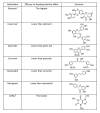Antioxidants in liver health
- PMID: 26261734
- PMCID: PMC4526841
- DOI: 10.4292/wjgpt.v6.i3.59
Antioxidants in liver health
Abstract
Liver diseases are a worldwide medical problem because the liver is the principal detoxifying organ and maintains metabolic homeostasis. The liver metabolizes various compounds that produce free radicals (FR). However, antioxidants scavenge FR and maintain the oxidative/antioxidative balance in the liver. When the liver oxidative/antioxidative balance is disrupted, the state is termed oxidative stress. Oxidative stress leads to deleterious processes in the liver and produces liver diseases. Therefore, restoring antioxidants is essential to maintain homeostasis. One method of restoring antioxidants is to consume natural compounds with antioxidant capacity. The objective of this review is to provide information pertaining to various antioxidants found in food that have demonstrated utility in improving liver diseases.
Keywords: Antioxidant; Coffee; Curcumin; Liver diseases; Naringenin; Oxidative stress; Quercetin; Resveratrol; Silymarin.
Figures

References
-
- Muriel P. Some experimental models of liver damage. In: Sahu SC, editor. Hepatotoxicity: From genomics to in vitro and in vivo models. West Sussex, England: Wiley; 2007. pp. 119–137.
-
- Muriel P. Cytokines in liver diseases. In: Sahu SC, editor. Hepatotoxicity: From genomics to in vitro and in vivo models. West Sussex, England: Wiley; 2007. pp. 371–389.
-
- Muriel P, Arauz J. Coffee and liver health. In: Chu Y, editor. Coffee emerging health effects and disease prevention. West Sussex, UK: IFT Press/Wiley-Blackwell; 2012. pp. 123–139.
-
- Reyes-Gordillo K, Segovia J, Shibayama M, Tsutsumi V, Vergara P, Moreno MG, Muriel P. Curcumin prevents and reverses cirrhosis induced by bile duct obstruction or CCl4 in rats: role of TGF-beta modulation and oxidative stress. Fundam Clin Pharmacol. 2008;22:417–427. - PubMed
-
- Muriel P. Peroxidation of lipids and liver damage. In: Baskin SI, Salem H, editors. Oxidants, antioxidants and free radicals. Washington, D. C. USA: Taylor & Francis; 1997. pp. 237–357.
Publication types
LinkOut - more resources
Full Text Sources
Other Literature Sources

